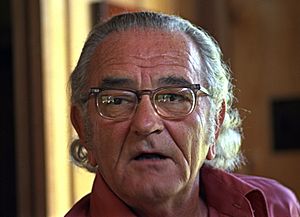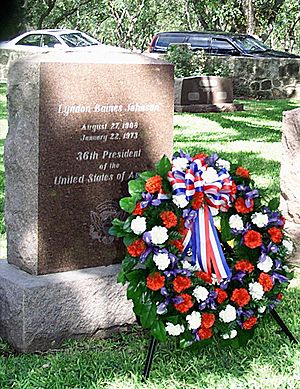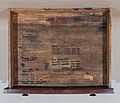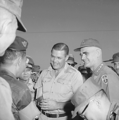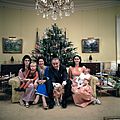Lyndon B. Johnson facts for kids
Quick facts for kids
Lyndon B. Johnson
|
|
|---|---|
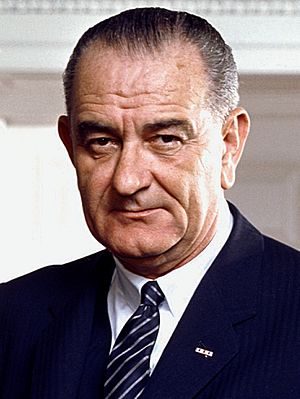
Johnson in 1964
|
|
| 36th President of the United States | |
| In office November 22, 1963 – January 20, 1969 |
|
| Vice President |
|
| Preceded by | John F. Kennedy |
| Succeeded by | Richard Nixon |
| 37th Vice President of the United States | |
| In office January 20, 1961 – November 22, 1963 |
|
| President | John F. Kennedy |
| Preceded by | Richard Nixon |
| Succeeded by | Hubert Humphrey |
| Senate Majority Leader | |
| In office January 3, 1955 – January 3, 1961 |
|
| Whip | Earle C. Clements Mike Mansfield |
| Preceded by | William F. Knowland |
| Succeeded by | Mike Mansfield |
| Senate Minority Leader | |
| In office January 3, 1953 – January 3, 1955 |
|
| Whip | Earle C. Clements |
| Preceded by | Styles Bridges |
| Succeeded by | William F. Knowland |
| Chair of the Senate Democratic Caucus | |
| In office January 3, 1953 – January 3, 1961 |
|
| Preceded by | Ernest McFarland |
| Succeeded by | Mike Mansfield |
| Senate Majority Whip | |
| In office January 3, 1951 – January 3, 1953 |
|
| Leader | Ernest McFarland |
| Preceded by | Francis J. Myers |
| Succeeded by | Leverett Saltonstall |
| United States Senator from Texas |
|
| In office January 3, 1949 – January 3, 1961 |
|
| Preceded by | W. Lee O'Daniel |
| Succeeded by | William A. Blakley |
| Member of the U.S. House of Representatives from Texas's 10th district |
|
| In office April 10, 1937 – January 3, 1949 |
|
| Preceded by | James P. Buchanan |
| Succeeded by | Homer Thornberry |
| Personal details | |
| Born |
Lyndon Baines Johnson
August 27, 1908 Gillespie County, Texas, U.S. |
| Died | January 22, 1973 (aged 64) Gillespie County, Texas, U.S. |
| Resting place | Johnson Family Cemetery |
| Political party | Democratic |
| Spouse | |
| Relations | Philip Bobbitt (nephew) |
| Children | |
| Parents |
|
| Education | |
| Occupation |
|
| Civilian awards | Presidential Medal of Freedom (posthumously, 1980) |
| Signature | |
| Military service | |
| Allegiance | United States |
| Branch/service | United States Navy |
| Years of service |
|
| Rank | |
| Battles/wars | |
| Military awards | Silver Star |
Lyndon Baines Johnson (August 27, 1908 – January 22, 1973) was the 36th president of the United States. People often called him LBJ. He became president in 1963 after John F. Kennedy was assassinated. Before that, he was the 37th vice president from 1961 to 1963.
During his time as president, Johnson helped pass many important laws. These laws changed things like civil rights, health care, and education. However, he faced strong criticism for his foreign policy, especially for America's involvement in the Vietnam War.
Early Life and Education
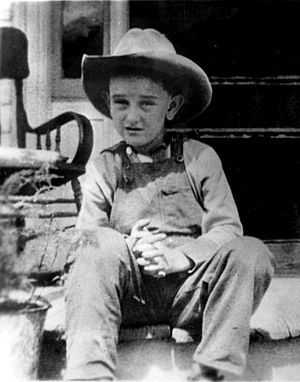
Lyndon Baines Johnson was born on August 27, 1908. His family lived in a small farmhouse near Stonewall, Texas. He was the oldest of five children. His parents were Samuel Ealy Johnson Jr. and Rebekah Baines.
Johnson grew up in a poor family. His father lost a lot of money. One writer said he was raised "in a land without electricity." It was also a place where the soil was very rocky, making it hard to earn a living.
School Days and Teaching Experience
Johnson finished Johnson City High School in 1924. In 1926, he went to Southwest Texas State Teachers College (SWTSTC). During his college years, he became very good at convincing people and organizing things.
For nine months, from 1928 to 1929, Johnson took a break from college. He taught Mexican-American children at the Welhausen School in Cotulla, Texas. This school was segregated, meaning it was only for certain groups of students. This job helped him save money to finish his education.
He graduated in 1930 with a degree in history. He also earned a certificate to be a high school teacher. He taught briefly at Pearsall High School. Then he taught public speaking at Sam Houston High School in Houston.
Years later, in 1965, Johnson remembered his time teaching. He said he would never forget the faces of the children at the Welhausen Mexican School. He realized that college was closed to almost all of them because they were too poor. He said that experience made him decide that America could not rest while knowledge was out of reach for any American.
Military Service in World War II

Johnson joined the United States Navy after the Japanese attacked Pearl Harbor in December 1941. He was called to active duty just three days later. He earned the Silver Star medal for his bravery in battle.
He also received other medals for his service. These included the American Campaign Medal, the Asiatic-Pacific Campaign Medal, and the World War II Victory Medal.
Journey to the Presidency
Johnson started his political career in 1937. He won an election to the U.S. House of Representatives. In 1948, he became a senator. He quickly rose through the ranks. By 1953, he was the Senate Democratic leader. In 1954, he became the Senate Majority Leader.
In 1960, Johnson tried to become president. However, Senator John F. Kennedy won the Democratic nomination. Kennedy then asked Johnson to be his running mate for vice president. The Kennedy-Johnson team won the election.
Vice President Johnson became president in 1963. This happened after President Kennedy was assassinated. Johnson was sworn in on Air Force One just hours after Kennedy's death.
Presidential Years (1963–1969)
During his time as president, Johnson wanted to improve life for all Americans. He focused on expanding civil rights, public broadcasting, and access to health care. He also worked on education, arts, and urban and rural development.
The Great Society and Fighting Poverty
Johnson launched a plan called the "War on Poverty". He wanted to create better living conditions for Americans with low incomes. As part of this effort, he signed the Social Security Amendments of 1965. This law created Medicare and Medicaid. Medicare helps older Americans with health care costs. Medicaid helps low-income families.
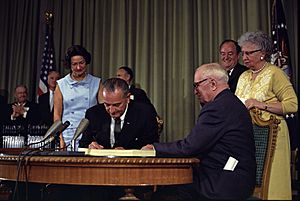
During Johnson's presidency, the number of Americans living in poverty dropped a lot. It went from 23% to 12%.
He also signed the Higher Education Act of 1965. This law created federal student loans to help more people go to college. The Immigration and Nationality Act of 1965 also became law. This act shaped how the U.S. handles immigration today.
Civil Rights Achievements
Johnson's biggest achievements were in civil rights. He signed three very important laws:
These laws helped end segregation and protect the voting rights of all Americans.
Space Program Progress

During Johnson's time, NASA made great progress in space. The Gemini program sent astronauts into space. The powerful Saturn V rocket was developed. NASA also got ready for the first crewed Apollo program flights.
In 1967, a fire during a test killed the entire crew of Apollo 1. This was a terrible tragedy. Johnson strongly supported the Apollo program even after this accident. The program recovered and continued. The first two crewed Apollo missions, Apollo 7 and Apollo 8, were completed before Johnson left office. Apollo 8 was the first crewed flight to the Moon.
On July 16, 1969, Johnson watched the launch of Apollo 11. This was the mission that first landed humans on the Moon. He was the first former or sitting U.S. president to see a rocket launch.
The Vietnam War
Johnson's foreign policy focused on stopping the spread of communism. This included the ongoing Vietnam War. When Kennedy died, there were 16,000 American military members in Vietnam. They were helping South Vietnam fight against North Vietnam, which was communist.
Johnson believed in the "Domino Theory". This idea said that if one country fell to communism, others nearby would follow. He decided to increase America's involvement in the war. After the Gulf of Tonkin Incident in 1964, he sent many more American troops to Vietnam. The number of U.S. soldiers and Vietnamese civilians who died increased greatly.
By 1968, the communist Tet Offensive made many Americans turn against the war. The anti-war movement grew stronger. Public opinion shifted, and people became frustrated with the war.
In October 1968, Johnson announced that he had ordered a complete stop to bombing North Vietnam. He hoped this would lead to peace talks. A week later, Richard Nixon won the 1968 presidential election. Johnson decided not to run for re-election because of the war's unpopularity and disappointing primary results.
Life After the Presidency (1969–1973)
After leaving the presidency in January 1969, Johnson returned to his ranch in Stonewall, Texas. He worked on his memoirs, The Vantage Point: Perspectives of the Presidency 1963–1969, which came out in 1971.
That same year, the Lyndon Baines Johnson Library and Museum opened. It is on the campus of the University of Texas at Austin. Johnson later left his Texas ranch to the public in his will. He wanted it to remain a working ranch, not just a museum.
Death and Legacy
Lyndon B. Johnson died on January 22, 1973, from a heart attack. He was given a state funeral. He was buried in his family's private cemetery at the house where he was born.
Many places and things are named after Johnson to honor him:
- The Johnson Space Center in Houston (renamed in 1973)
- The United States Department of Education headquarters (named in 2007)
- The Lyndon B. Johnson School of Public Affairs at the University of Texas at Austin
- The Lyndon B. Johnson National Grassland
- Interstate 635 in Dallas, known as the Lyndon B. Johnson Freeway
- The Lyndon Baines Johnson Memorial Grove on the Potomac (dedicated in 1976)
In 1980, Johnson was given the Presidential Medal of Freedom after his death. Texas also created a state holiday on August 27, his birthday, called Lyndon Baines Johnson Day.
Key Laws Signed by President Johnson
Johnson signed many important laws during his presidency. Here are some of them:
- 1963: Clean Air Act
- 1963: Higher Education Facilities Act
- 1964: Civil Rights Act
- 1964: Wilderness Act
- 1964: Food Stamp Act
- 1964: Economic Opportunity Act
- 1965: Higher Education Act
- 1965: Social Security Act (created Medicare and Medicaid)
- 1965: Voting Rights Act
- 1965: Immigration and Nationality Services Act
- 1966: Animal Welfare Act
- 1966: Freedom of Information Act
- 1967: Public Broadcasting Act
- 1968: Civil Rights Act
- 1968: Gun Control Act
Important Changes Made
Books Written by Johnson
- National Aeronautics and Space Act (1962)
- Choices We Face (1969)
- The Vantage Point (1971)
Images for kids
-
Johnson's boyhood home in Johnson City, Texas
-
Opening Day of the 1961 baseball season. President Kennedy throws out the first ball. LBJ and Hubert Humphrey are watching.
-
Vice President Johnson visiting Finland in September 1963. He is with Mrs. Johnson as Urho Kekkonen, the President of Finland, welcomes them.
-
LBJ is sworn in on Air Force One by Judge Sarah Hughes. Mrs. Johnson and Mrs. Kennedy are watching.
-
Meeting with civil rights leaders Martin Luther King Jr. (left), Whitney Young, and James Farmer in the Oval Office in 1964.
-
President Lyndon B. Johnson, Martin Luther King Jr., and Rosa Parks at the signing of the Voting Rights Act of 1965 on August 6, 1965.
-
Former president Harry S. Truman and his wife Bess Truman at the Medicare Bill signing in 1965. Lady Bird Johnson and Hubert Humphrey are also watching.
-
Former President Lyndon B. Johnson (center left) and Vice President Spiro Agnew (center right) watch the launch of Apollo 11.
-
Lady Bird Johnson and LBJ with Ferdinand Marcos and Imelda Marcos on September 12, 1966.
-
Shah of Iran Mohammad Reza Pahlavi and Queen Farah Pahlavi with the Johnsons during their visit to the United States.
-
Secretary of Defense Robert McNamara and General Westmoreland in Vietnam 1965.
-
Philippines President Ferdinand Marcos hosting leaders of SEATO nations during the Manila Conference on the Vietnam War.
-
Johnson talking with his Secretary of Defense Robert McNamara, 1967.
-
Walt Whitman Rostow shows President Lyndon B. Johnson a model of the Battle of Khe Sanh area in February 1968.
-
Soviet Premier Alexei Kosygin (left) next to Johnson during the Glassboro Summit Conference.
-
President Johnson meets with Republican candidate Richard Nixon in the White House, July 1968.
-
Johnson in the Oval Office in 1969, a few days before Richard Nixon's inauguration.
-
With the appointment of Thurgood Marshall, Johnson placed the first African American on the Supreme Court.
-
Johnson lying in state in the United States Capitol rotunda.
-
Johnson's image as it appears in the National Portrait Gallery in Washington, D.C.
-
Front view of the Lyndon Baines Johnson Library and Museum on the campus of the University of Texas at Austin in Austin, Texas.
See also
 In Spanish: Lyndon B. Johnson para niños
In Spanish: Lyndon B. Johnson para niños


